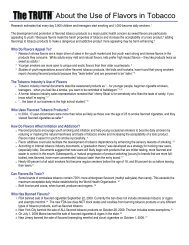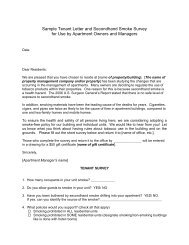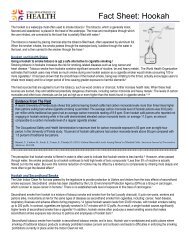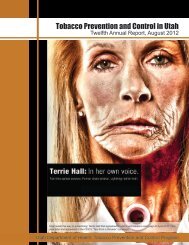TPCP Annual Report - Utah Tobacco Prevention and Control Program
TPCP Annual Report - Utah Tobacco Prevention and Control Program
TPCP Annual Report - Utah Tobacco Prevention and Control Program
You also want an ePaper? Increase the reach of your titles
YUMPU automatically turns print PDFs into web optimized ePapers that Google loves.
<strong>Tobacco</strong> Use in <strong>Utah</strong>Figure 2.Percent of Adults Who <strong>Report</strong>ed CurrentCigarette Smoking, <strong>Utah</strong> 1999-2010(Age-adjusted)PercentageSource: <strong>Utah</strong> BRFSS 1Figure 3.Percent of High School Students Who<strong>Report</strong>ed Current Cigarette Smoking,<strong>Utah</strong> 1999-2009 (Odd Years)PercentagePercentageSource: <strong>Utah</strong> YRBS 2Figure 4.Percent of Pregnant Women Who<strong>Report</strong>ed Cigarette Smoking, <strong>Utah</strong>1999-200925Source: <strong>Utah</strong> Birth Certificates 3Figure 5.Age-adjusted Cancer Incidence Rates forLung <strong>and</strong> Bronchus Cancer, Incidence per100,000 Population, <strong>Utah</strong> 1999-2007Percentage20151050Source: <strong>Utah</strong> Cancer Registry 442520151050252015105060504030201008.2199913.512.513.012.511.910.111.29.511.29.19.58.8199911.919998.134.6199920017.6200128.07.120036.520032005Year6.3Year200720098.3 7.3 7.4 7.9 8.5200131.12001200329.0Year31.32003Year20055.95.95.85.46.5200528.82007200730.1200528.32009200926.22007Smoking Rates <strong>and</strong> Health ConsequencesAdult Smoking• At 8.8%, <strong>Utah</strong>’s 2010 age-adjustedadult smoking rate is at its lowestrecorded level (Figure 2). 1 Due tochallenges in surveying smokersby telephone, this rate mayunderrepresent adult smokingprevalence. Updates to the BRFSSmethodology are expected to lead toimproved estimates. 5• Smoking disproportionately impacts<strong>Utah</strong>ns with lower incomes. In 2010,16% of <strong>Utah</strong> adults with a householdincome of less than $25,000 reportedcurrent smoking. 1 In comparison, only4% of <strong>Utah</strong> adults with a householdincome of $75,000 or higher reportedcurrent smoking. 1Youth Smoking• Since 1999, the percentage of <strong>Utah</strong>high school students who had ever triedcigarette smoking declined by 40%. 3• The percentage of high school studentswho reported current smokingdecreased from 12% in 1999 to 8% in2001. Since 2001, it has remained inthe range of 7.3% to 8.5% (Figure 3). 2Smoking Among Pregnant Women• Since 1999, smoking among pregnantwomen has decreased by 21% (Figure4). In 2009, 6.5% of pregnant womenreported that they smoked during theirpregnancies. 3References:• Pregnant women in their teens <strong>and</strong>pregnant women with a high schooleducation or less continue to reportsmoking rates of 13% or higher. 3Exposure to Secondh<strong>and</strong> Smoke• In 2010, 1.9% (or 16,600) <strong>Utah</strong>children age 17 <strong>and</strong> younger wereexposed to secondh<strong>and</strong> smoke insidethe home. 1 The percentage of <strong>Utah</strong>children who live in homes wherepeople smoke indoors has declinedsignificantly since 2001.• Since 1999, the percentage of <strong>Utah</strong>adults who have a rule against smokingin their homes has increased from 87%to 93%. 1<strong>Tobacco</strong>-related Disease <strong>and</strong> Death• Smoking is the leading cause of lungcancer death in men <strong>and</strong> women.Other diseases caused by smokinginclude esophageal, laryngeal, oral, <strong>and</strong>throat cancers; cervical, bladder, kidney,pancreatic, <strong>and</strong> stomach cancers; acutemyeloid leukemia; pneumonia; chroniclung disease; cataracts; periodontitis;aortic aneurysm; <strong>and</strong> coronary heart<strong>and</strong> cardiovascular disease.• <strong>Utah</strong>’s lung <strong>and</strong> bronchus cancerincidence has decreased significantlysince 1999 (Figure 5). 4• Despite this progress, more than 1,200<strong>Utah</strong>ns age 35 or older die each yearas a result of tobacco use. 61 <strong>Utah</strong> Department of Health. Behavioral Risk Factor Surveillance System (BRFSS). 1999-2010. Salt Lake City: <strong>Utah</strong> Department of Health.Center for Health Data.2 YRBSS: Youth Risk Behavior Surveillance System. Youth Online: Comprehensive Results. Retrieved August 2, 2011, from http://apps.nccd.cdc.gov/YouthOnline/App/Default.aspx3 <strong>Utah</strong> Birth Certificate Database. Retrieved July 25, 2011 from <strong>Utah</strong> Department of Health, Center for Health Data, Indicator-BasedInformation System for Public Health at http://ibis.health.utah.gov. These smoking rates are based on pregnancies that led to livebirths.4 <strong>Utah</strong> Cancer Registry. Retrieved July 25, 2011 from <strong>Utah</strong> Department of Health, Center for Health Data, Indicator-Based InformationSystem for Public Health web site: http://ibis.health.utah.gov.5 Office of Public Health Assessment. <strong>Utah</strong> Behavioral Risk Factor Surveillance System. New Behavioral Risk Factor Surveillance System(BRFSS) Weighting Methodology. <strong>Utah</strong> Department of Health. Retrieved August 3, 2011 from http://health.utah.gov/opha/OPHA_BRFSS.htm.6 National Center for Chronic Disease <strong>Prevention</strong> <strong>and</strong> Health Promotion. (2010). <strong>Tobacco</strong> <strong>Control</strong> State Highlights 2010. Atlanta,GA: U.S. Department of Health <strong>and</strong> Human Services. Retrieved August 16, 2011 from http://www.cdc.gov/tobacco/data_statistics/state_data/state_highlights/2010/states/utah/index.htm.







